Can you guess this song by its Drum Track?
Dark Money in the Windsor Mayoral Election
Note: This post originally appeared on NextDoor
Look, I get it – we’re all tired of posts about the Windsor Mayor Election, but rather than persuade you to vote for one candidate over another, I am posting on Election Day to raise some concerning information about Dark Money that infested our local elections.
“‘Dark money’ refers to spending meant to influence political outcomes where the source of the money is not disclosed.” – OpenSecrets (more at https://www.opensecrets.org/dark-money/basics )
After examining all of the Financial Disclosures at https://www.windsorgov.com/1256/Campaign-Finance-Reports and charting them based on expenditures, over 1 in every 4 dollars spent in this election has been by a Nonprofit Corporation called “Advancing Northern Colorado.” Based out of Loveland, they do not disclose their donors and do not have to abide by the contribution limits imposed on the candidate committees. As you can see, this has opened a pipeline of funding into our elections that cannot be traced. In this case, all the money was spent supporting one candidate.
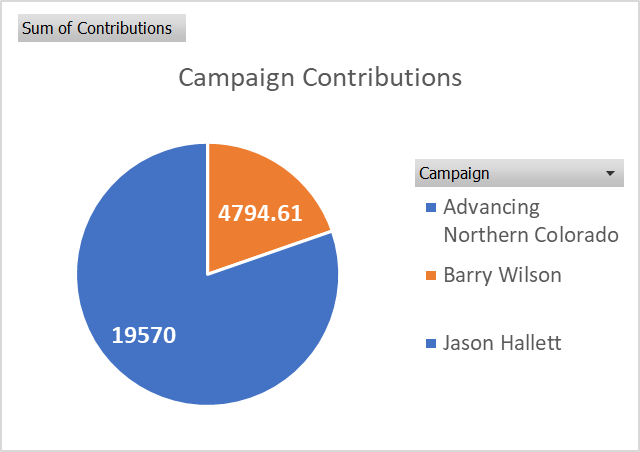
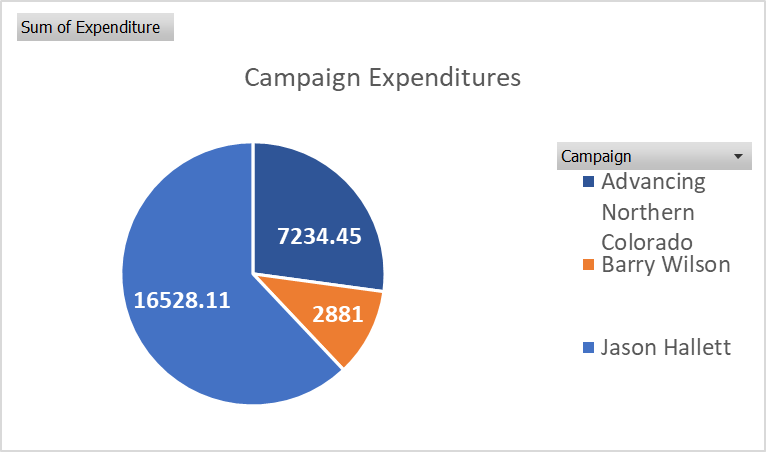
Expenditures by Advancing Northern Colorado include $2734 for text messaging campaigns, while an additional $4500 for “Hallett for Mayor Creative Development” and “Ad Placement.”
I have raised earnest questions regarding these expenditures at https://nextdoor.com/news_feed/?post=327303868 and appreciate the candidate’s response. I invite you to review the post and comment threads and consider them.
My intention is not to promote or embarrass any candidate but to raise awareness of how these financial practices impact our elections. I believe strongly in election integrity, and while I cherish freedom of speech, I also believe strongly in financial disclosure so we can understand how messaging is funded. As a community, we need to have some very serious discussions about Dark Money and its place in our local political discourse.
My Broncos Ticket Dilemma
An open letter to my Broncos-loving family and friends:
I need to level with you and vent about what is more definitely a first-world problem, but it’s a problem nonetheless.

With last year’s football season in the rearview mirror, my focus is shifting to renewing the Broncos tickets for the next season. Once again, the invoice has caused sticker shock, as the Broncos have raised ticket prices by a double-digit percentage, and at this point, I’m at a loss as to what I should do.
In the spirit of transparency, I will be upfront about the ticket costs. Below is a breakdown of the costs since we moved down to Section 131 (but I should note that we were paying the same costs the prior year when we were in Section 234):
| Year | Face Value* | Total Season Invoice Cost | Adjusted Sale Price** | Y/Y % Increase | Since 2021 % Increase |
|---|---|---|---|---|---|
| 2021 | $104 | $4160 | $110 | – | – |
| 2022 | $116 | $4640 | $130 | 11.54% | 11.54% |
| 2023 | $136 | $5440 | $144 | 17.24% | 30.77% |
| 2024 | $151 | $6040 | $169 | 11.03% | 45.19% |
* Years ago, the Broncos introduced dynamic pricing to mask the full-price costs they charged for preseason tickets. Now, they arbitrarily set ticket prices depending on the opponent and whether the game is in prime time. However, I’ve always maintained the same formula of dividing the invoice price by 4 (the number of seats) and 10 (the total number of games).
** My adjusted sales price has always been setting the preseason games by half, then spreading the other half between the other 8-9 games. Next year, the Broncos have 2 preseason games and 8 regular season games. The 2025 adjusted price would be $160 if the prices stay the same. I have never made a profit on any of my tickets, and in fact, I end up eating some or all costs on the preseason tickets. =
In reviewing this chart, the dilemma becomes evident: Are you willing to pay $169/ticket to sit in Sec 131 in 2024? What was once an easy answer has given me significant pause, as the Broncos are now eight years from their last winning season and set to rebuild in 2024. As much as I’m grappling with absorbing the price increase, I don’t think it’s fair to my family and friends that I assume you can do the same.
As I’ve been pondering this dilemma, I see 4 options:
- Maintain the same formula. Last year, tickets for 2 were $288; this year, they would now be $338. If you want to buy all 4, the price is now $676.
- Revert to Face-Value, variable pricing. When the schedule is released and the tickets are “printed” over the summer, prices will be assigned to the games for the year. Prime Time (if we get them) and “marquee games” (e.g. The Chiefs) will likely be more, preseason would still be 1/2 price, and the lowest you’d see a game would be $151.
- Pursue shifting up a section further away from the field. Ticket costs would likely decrease, but there’s no guarantee we’d get aisle seats or a section similar to 234. If you haven’t experienced those seats, the energy is very different and exciting.
- Do not renew the season tickets. This is an option I want to avoid, but I need to have it on the table.
Update 3/11, 5pm:
Hey, thank you for taking the time to give me feedback! I appreciate it and have taken your words to heart! I hope I’m not giving off the impression that I want to cancel my season tickets. In the spirit of due diligence, it’s on the table, but it’s really my last resort. I’m blessed enough to afford the tickets, and while the girls have reached an age where they’re enjoying the games, they only want to go to a couple each season. That leaves me hoping that other friends and family would also like to attend these games, and I want to see whether the prices are too steep for my fellow Broncos Country.
Please keep your feedback coming, and if you’d like to be on my family & friends email list for tickets, send me a DM. I’ll send out the first email towards the end of June.
Now that I’ve laid out my thoughts, I’d love to hear yours. Over the years, I’ve had these seats, you have reliably purchased tickets, and we have enjoyed many games together. I don’t take that for granted, which is why I’m anxious to hear what you think. Please feel free to comment below or email me at jeromey [at] balderrama.org.
In orange and blue,
-Jeromey
Mariana’s New Bedroom!
Last weekend, we took on the weekend project of re-imagining Mariana’s bedroom. This has been her bedroom since her birth, but before that, it was also Clara’s nursery. While upgrades have been made to her room over the years, her room has still been virtually based on the same color scheme and layout up to this point.

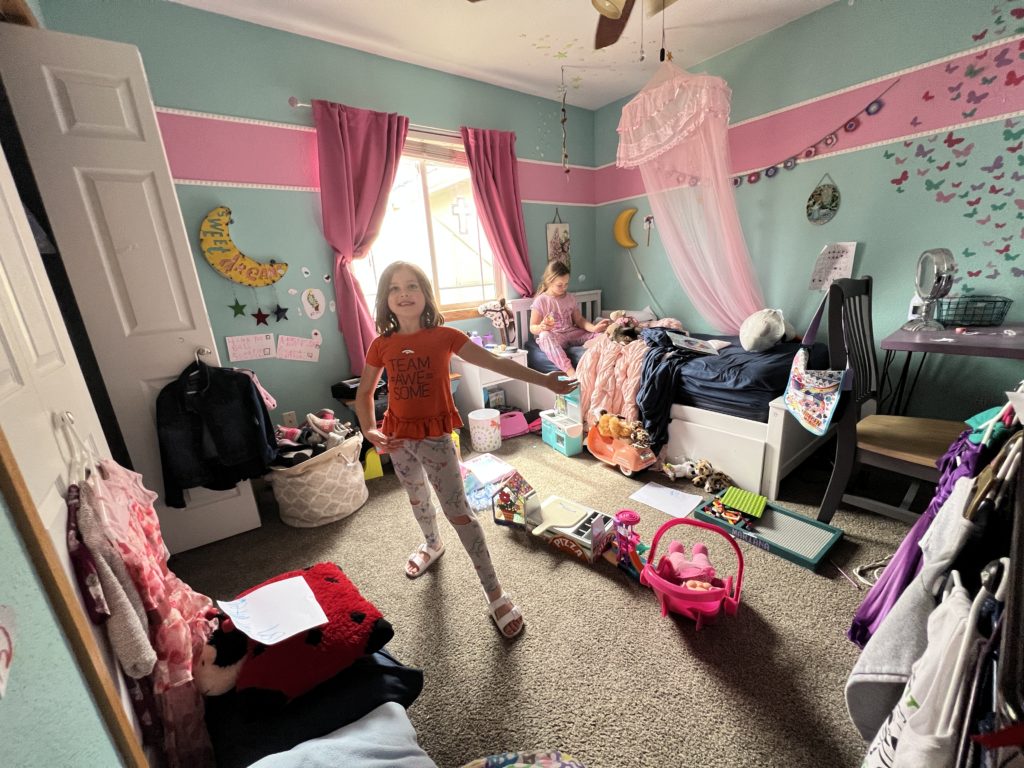
With Clara being busy at a dance competition all weekend, this was a great opportunity for Mariana and me to be productive in the house. Mariana picked out the colors, and we took to Pinterest to get some ideas. After exploring many options, Mariana narrowed her choice down to a grey bedroom with a light blue accent wall, rejecting complex shapes and patterns that were floated to her.
The project went into full force last Wednesday when I took all of the furniture out of her room (Maraina was with her mom for the next two nights).

The next night I focused on getting everything off of the walls and doing a lot of patching.

When I got the girls back Friday morning, we picked up the paint and went to town. My mom joined us and both girls were amazing helpers, and we were reminded how satisfying painting can be.
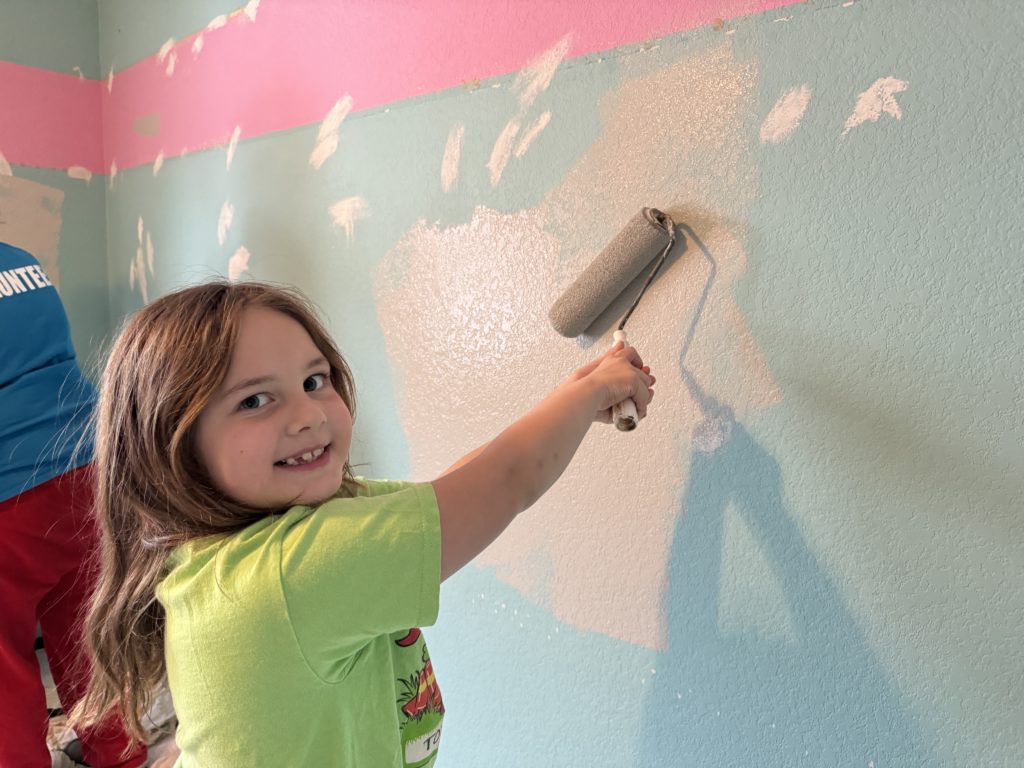
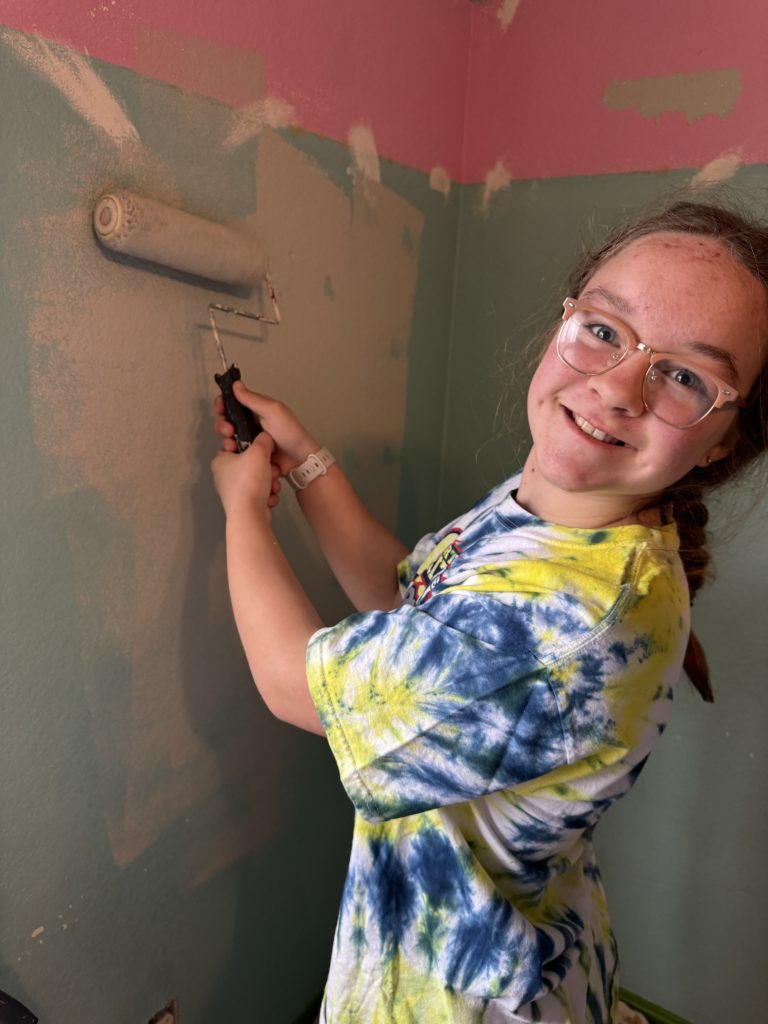
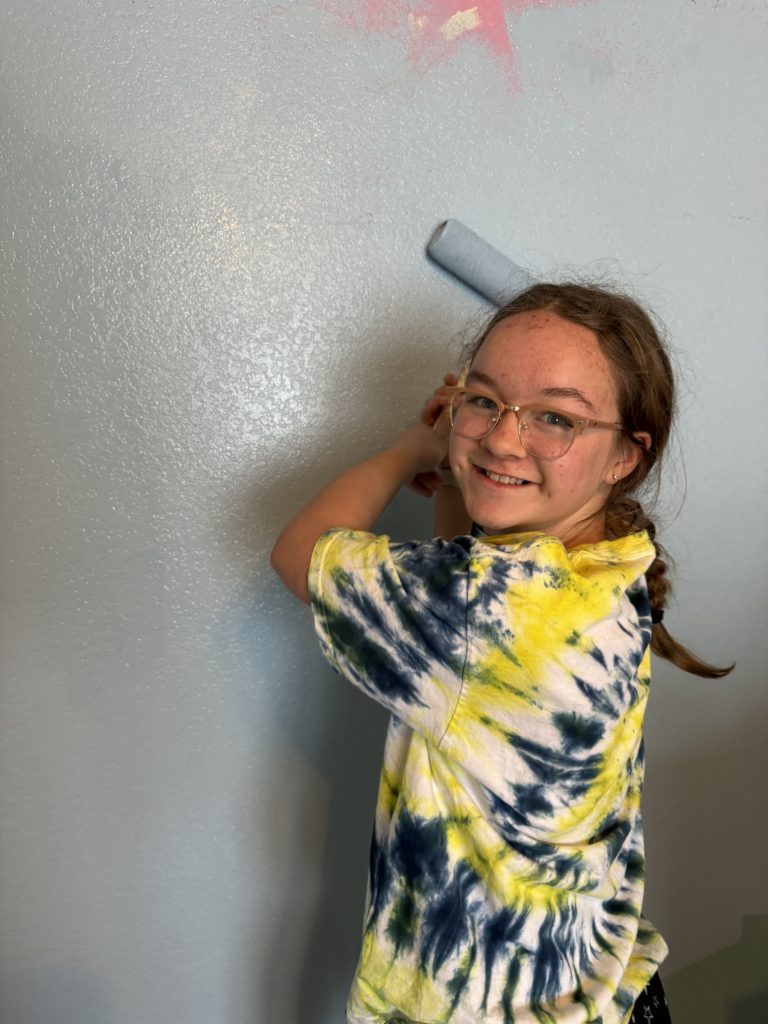
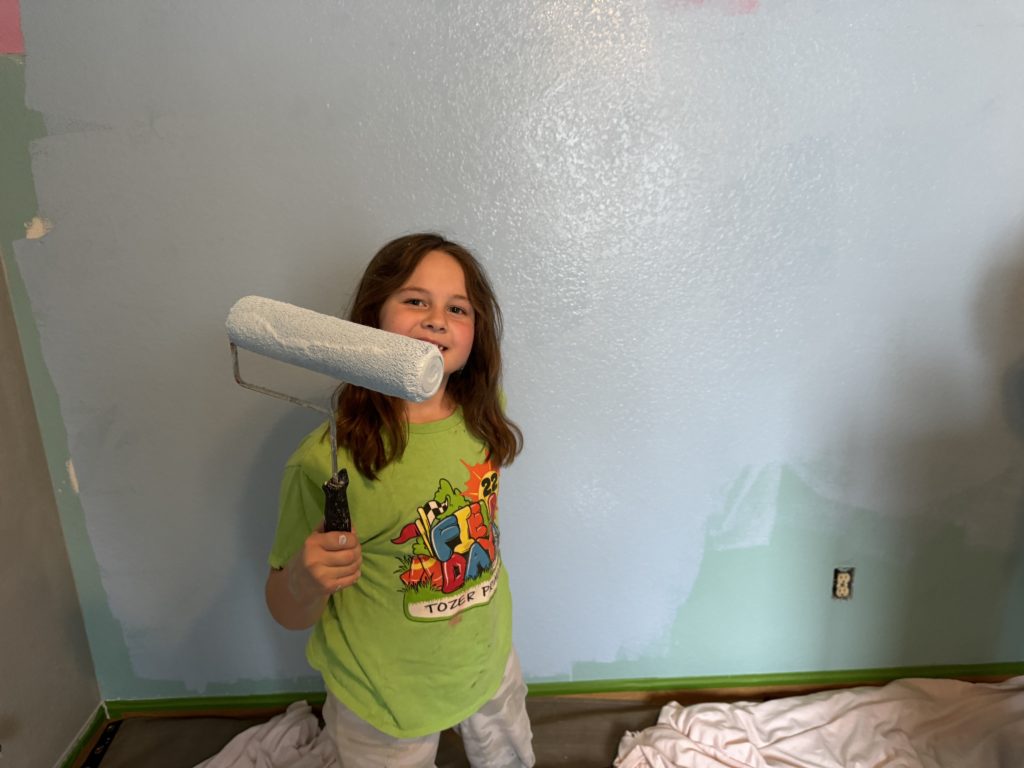
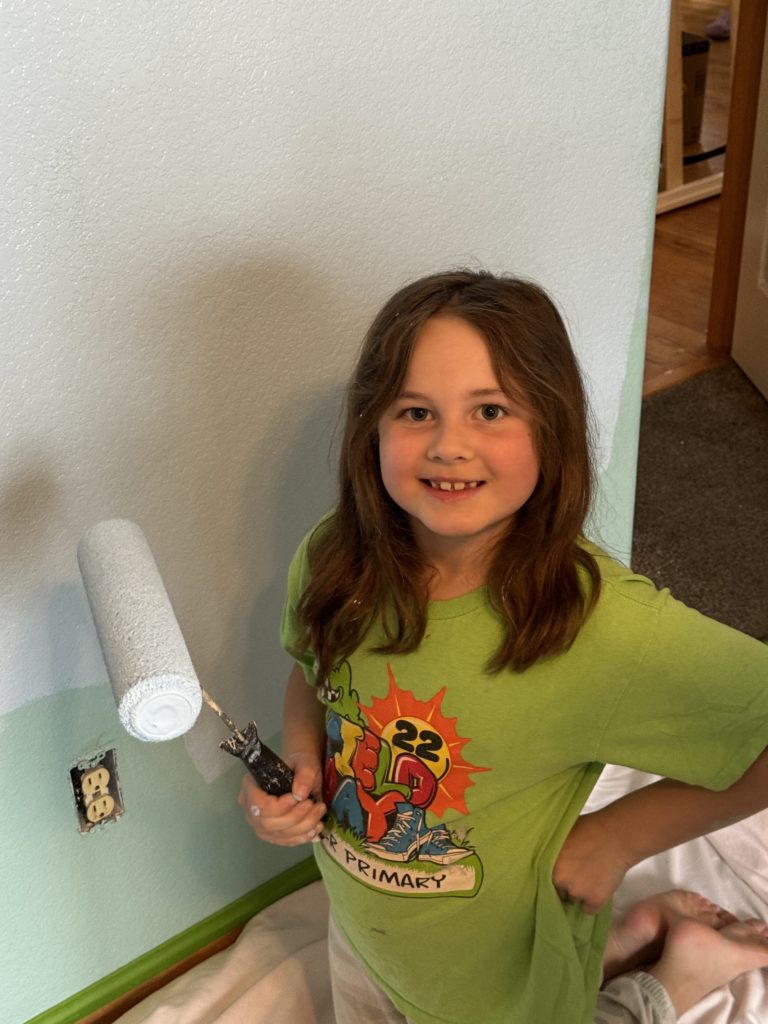


By day’s end, the paint dried enough to set up Mariana’s bed and move some furniture back into the room. She was excited to sleep in this in-progress project.
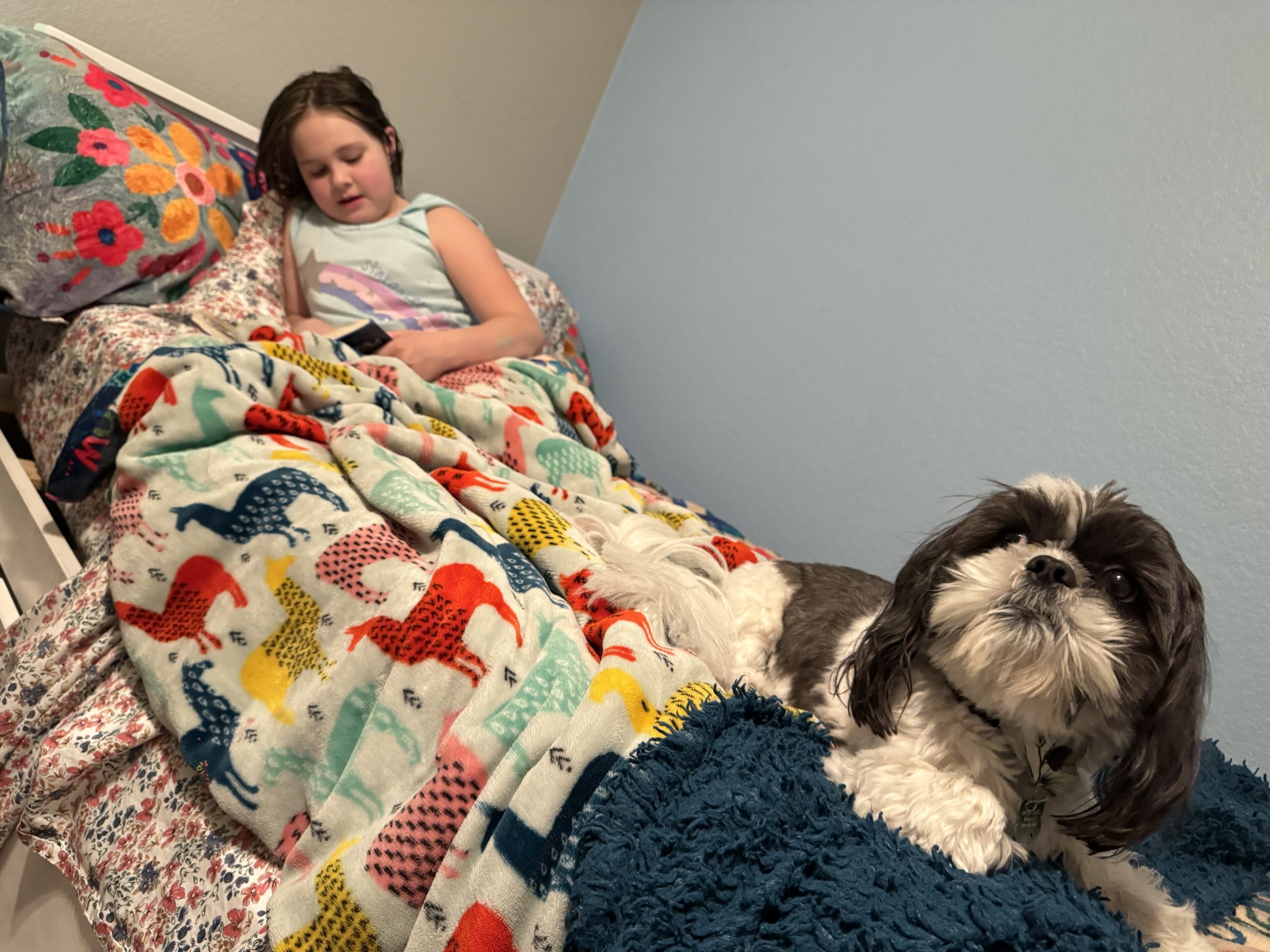
Saturday came, and Clara spent the day at her dance competition. My mom came over, and the three of us started getting the lights, shelving, wall fixtures, and all of the furnishings into the room. We had a lot of fun playing with string lights, threading them along the ceiling down her dresser wall. We swapped the location of her bed and dresser, and I replaced her nursery dresser with an amazing wooden dresser I got in an estate auction. My mom also replaced Mariana’s desk with a new-to-her desk. I also mounted Mariana’s TV to the wall to open up her dresser space. We tried to be more selective about adding things back into the room, taking the opportunity to de-clutter as much as we can.
Here is the current result, with a few more decorations to add, along with some on-the-wall shelving that will arrive next week.

Mariana is excitedto offer a tour:
I’m so very grateful for all the people who helped make this happen: my mom, who helped paint and decorate; Shannon, who helped me get the dresser. Next up: Clara’s room this summer? Stay tuned!
Tubing at Beaver Meadows

The girls and I have been clamoring to go tubing since early December, but the mild winter and a busy schedule prevented us from going. We finally carved out time in late January to make our way up to Beaver Meadows Resort near Red Feather and had an absolute blast.
The last time I had been to Beaver Meadows was during my Campus Ministry Days at John XXIII, over 20 years ago. As I was researching tubing locations online, Beaver Meadows made the most sense when considering experience, price, and travel time. We purchased our tickets the night before and booked a 2-hour window from 12-2.
The drive up there was pretty, and with the mild winter, the roads didn’t give us any trouble. We stopped at Subway in Fort Collins and picked up lunch for afterward.
The tubing hill is very well-run. They have a pully-lift system that brings you up by your tube, and once you’re up there are multiple runs to choose from. As someone with a moderate tolerance for speed, I didn’t find the runs too scary. The girls learned the hard way that you may not want to go down head-first, but we luckily escaped injury and enjoyed our other runs.
We used the GoPro to capture some videos of our runs. Clara wore it at first and took some awesome videos:
She and Mariana also formed a train down one of the runs as well.
I also joined in on the train, but had to take the front on this run:
Finally, Mari and I took one last “race” down one of the parallel runs:
Despite having a lift take you to the top of the hill, tubing took more out of us than we expected. By the time our two-hour window was up, we were ready to be done and enjoy our lunch in the back of the truck:
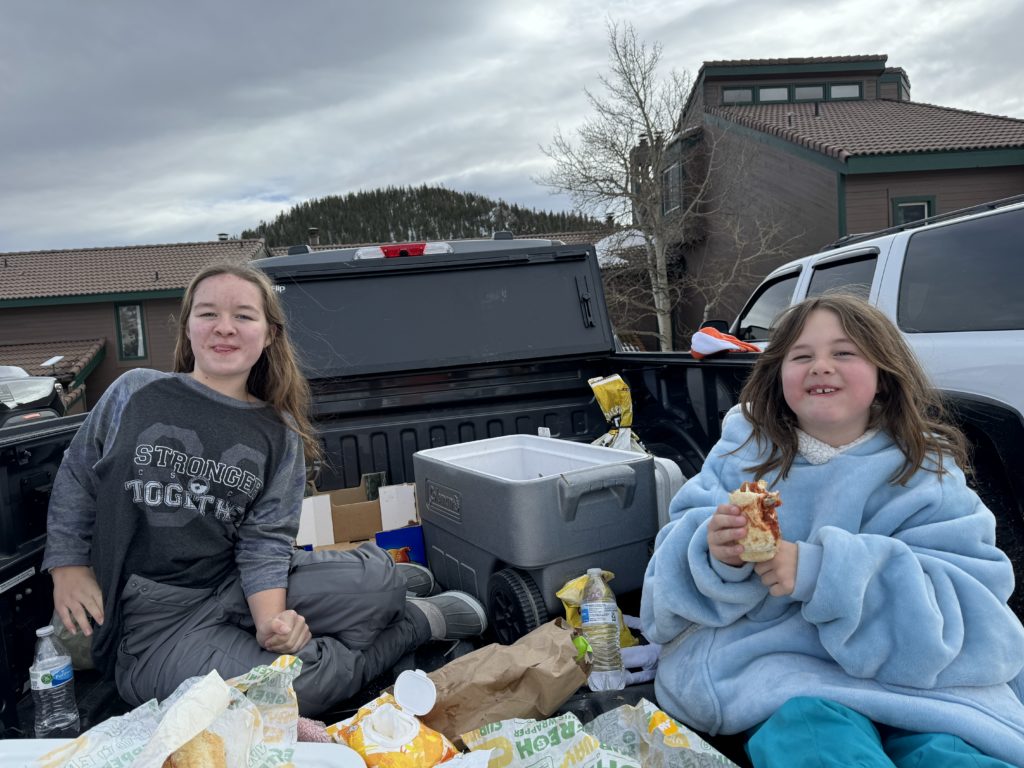
We would highly recommend going to check out Beaver Meadows. They’re open on weekends through Spring Break and will scratch that itch for some winter fun.





